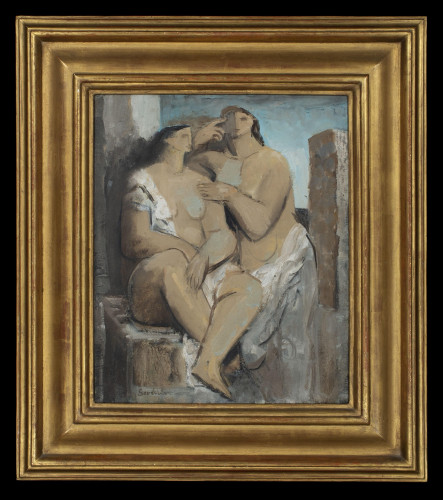Laurence Edwards a.R.B.S 'B. 1967' : 'Arc', 1997
11289
Artist Laurence Edwards A.R.B.S (B. 1967) arc. Arc is an early work by Edwards that he executed in aluminum and bronze in 1997 as an experiment in 'mixed metal casting.' Bronze elements were first cast using the lost wax method. A wax cast of a flint and wax splashes were added to the bronze elements, the whole assemblage was then re 'invested' in a mould, the wax melted away in a kiln, and aluminum poured in to the mould to take the form of the flint etc fusing with the bronze pieces. Fundamentally an abstract piece, Arc brings together elements from nature (such as the rock-like form on the left) and debris and various objects from the workshop (nails etc) to produce a quietly balanced ensemble.
'I saw this method in India whilst working with traditional casters, there they would work with the five sacred metals, (gold, silver, copper, zinc and lead.) to create incredible figurative idols'.
About Laurence Edwards.
Edwards work often echoes his feelings for the Suffolk landscape. His figurative sculptures absorb forms from the landscape, fused with plant matter, and reflect the survival of an ancient culture. 'Sometimes I think that this place, this part of Suffolk, has made me. At least I am sure it has made the way I see'
'Water shapes the world here, sweeping in to touch and change everything. My studio is by this water on Butley Creek, on the frontiers of the sea; a land of heath and wood, mud and marsh and tide. Every day the water floods in over the marshes, and chews at the cliffs. In the space of a morning, a vista that shimmers with water drains to slurp with mud. Water changes the pressure in the air, and in turn the thoughts in the head. I experience these changes constantly. I see the water lap up to the flood defences surrounding the studios, I know that one day it will overwhelm this place'.
'Some would say that this land around me is flat. For me it undulates. It has secret places, enough to sustain an inquisitive mind. It has mystery. In the distance a slight incline marks a Saxon burial ground, under this ground are 600 bodies dissolved into sand'
Edwards knowledge and ability to be able to cast his own work is unusual and provides him with artistic opportunities that the majority of sculptors who hand over the casting process to independent foundries relinquish. Edwards was taught the lost wax, Cire Perdure method of casting bronze by Tissa Rasinghe at the Royal College of Art. He passed on the knowledge and techniques which he had learned from the infamous Angeloni Brothers, a generation of Italian casters whose knowledge of has been passed down the family line since the Italian Renaissance. Edwards went on to travel in India and Nepal working with traditional casters and discovered ' the space one can find in a process and how character can be given to an object through the personality of the caster that delivers it. Casting has now worked its way into my thought process, so that I plan to solve problems at various moments. I can allow the process to make marks and leave scars, it is like another mind.'
Edwards has also sought out ancient sculptures and artifacts associated with the early history of Suffolk, reading widely around the subject. Visits to the British Museum, for example, revealed a wealth of material, including the stunning Sutton Hoo, Mildenhall, and Hoxne treasures. A 1st century AD bronze head of the Emperor Claudius also made a deep impression. Probably hacked off a life-size equestrian statue during the sacking of Colchester by the Iceni, it was thrown into the river at Rendham, perhaps as an offering to the gods, only to be discovered in 1907 by a boy fishing. Gradually, Edwards developed ideas for his new work: to consider what it is to be human, male, living where he is, when he is, and connecting with the landscape in all its guises - its geology, geography, biology and history.
Edwards's identification with, and use of, old English local, historical and cultural sources, might, as he suggests, appear to push his work away from the post-modern frame of reference. Sadly, the supposedly 'outmoded' practices of working in clay and bronze, or with the figure, have long had superficial, misplaced connotations of tradition, conservatism and conformity. Edwards feels a strength in belonging to a bronze casting line which stretches back to the Italian Renaissance, to extraordinary talents like Donatello, and beyond. Characteristically, he also remains steadfast in his conviction that his closeness to the land and its culture and his developing artistic engagement with the natural environment and its cycles and rhythms, lie at the heart of his sensibility. And far from denoting a reactionary, it is clear that these qualities complement progressive, contemporary thinking and understanding of the natural world and our place in it, and the importance of our cultural identity.
20th Century
1997
Bronze
United Kingdom
Collectors
Post-Modern (Of the period)
Commemorative
EXCELLENT
1















